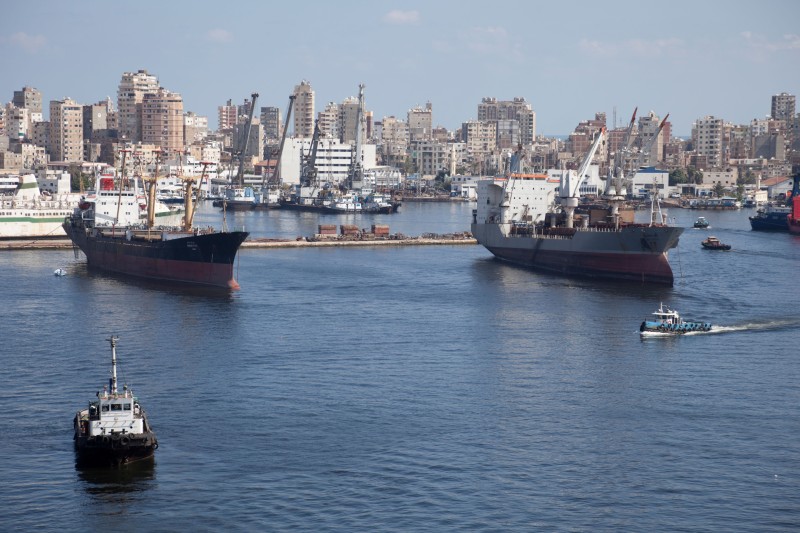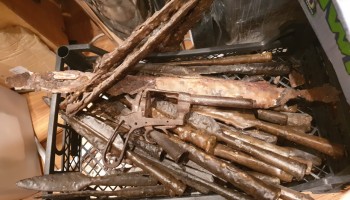A Russian company with a history of selling grain from occupied areas of Ukraine exported over 20,000 tons of wheat that unloaded in Egypt last month after re-routing from Syria, documents obtained by OCCRP show.
The company, Pallada LLC, had received small quantities of wheat from the occupied parts of the Zaporizhzhia region during the two months before the cargo set off, the documents show. OCCRP was unable to obtain data from before or after that period, or verify if the shipment to Egypt specifically contained grain from occupied regions.
The vessel, known as the Mikhail Nenashev, was originally destined for Syria with over 27,000 tons of wheat, according to an official Russian sanitary certificate, a type of document used to clear agricultural products for export. The certificate was dated Nov. 28.
The ship first appeared on ship tracking data November 29 in the Black Sea, headed toward Istanbul. After President Bashar al-Assad’s regime collapsed in Syria on December 8, it loitered near Cyprus for nearly three weeks and then anchored in the Egyptian port city of Alexandria on December 30.
The vessel arrived with a cargo of wheat destined for “Minister of Defense/Future of Egypt,” according to data from the Egyptian Maritime Transport and Logistics Sector, a state agency.
“Future of Egypt” — which was written in English in the data — is the direct translation of Mostakbal Misr, a military agency that took over the import of strategic commodities late last year, replacing the General Authority for Supply Commodities as Egypt’s main wheat buyer.
The Egyptian data says the shipment was 24,290 tons — about 3,000 less than the amount recorded in the Russian sanitary certificate. The reason for the discrepancy was not immediately clear. But the cargo does appear to be the same, based on the timeline of the vessel’s movement indicated by the Egyptian data, the sanitary certificate, and ship tracking data.
The Egyptian data does not say how much the agency paid for the shipment. Based on the global average price of wheat in December, the amount that arrived would have been worth about $6.7 million.
The Russian sanitary certificate, obtained by OCCRP, specifies that the cargo had been exported by the Russian company, Pallada. Ukraine has previously accused the company of selling “stolen” grain from occupied regions — a claim supported by Russian export quota permits and other documents reviewed by OCCRP.
Ukraine has tried to dissuade countries from purchasing shipments it thought were loaded with grain from occupied regions. In May 2022, Ukraine thanked Egypt for turning away a vessel that Kyiv said was loaded with stolen grain.
Before Assad’s fall, Ukraine repeatedly accused Syria of buying such shipments. Russia was Assad’s main backer during the civil war, providing extensive air and other military support.
"Russia has committed a triple crime: it bombed out Syria, temporarily occupied a part of Ukraine, and is currently selling Ukrainian grain it has stolen there to Syria,” the Ukrainian foreign ministry said in May 2022.
Pallada did not reply to requests for comment. Neither did Mostakbal Misr, the port of Sevastopol, or the Russian Ministry of Agriculture. The Russian Service for Veterinary and Phytosanitary Surveillance did not provide a response in time for publication.
Pallada’s History With ‘Stolen’ Grain
The Mikhail Nenashev’s port of departure is difficult to trace.
The port’s name does not appear in the November 28 sanitary certificate. The ship turned off its tracking system repeatedly before arriving in Egypt, and its departure point is not clear in publicly available data.
In January, Kateryna Yaresko, from the investigative project SeaKrime of the Ukrainian Myrotvorets Center, wrote on the social media platform X that the ship had been loaded in late November at the Avlita terminal of the occupied Sevastopol port in the Crimean Peninsula. OCCRP was unable to verify the claim.
Yörük Işık, a maritime scholar with the Middle East Institute, took a picture of the Mikhail Nenashev crossing the Bosphorus Strait at 2:47 a.m. local time on December 1. That would fit with the timeline of a departure from Sevastopol shortly after a November 28 inspection, though it does not rule out other ports.
Pallada, the shipment’s exporter, was registered in August 2022 and is 89-percent owned by Sergey Yurievich Kuznetsov, a low-profile Russian businessman. Despite extensive online searches, OCCRP was not able to find any evidence he was involved in the grains sector before Pallada.
Export quota documents issued by Russian-backed authorities in occupied parts of Ukraine’s southern Kherson region show that Pallada received permission to export thousands of tons of wheat, barley, and meslin from the occupied regions in 2023. The documents, reviewed by OCCRP, were originally reported by the Belarusian Investigative Center and partners last year.
More recently, the company received wheat from occupied districts of the Zaporizhzhia region in the two months before the Mikhail Nenashev departed, according to quarantine certificates obtained by OCCRP.
The certificates — used during domestic transport from farms or storage points to port — show that Pallada received three batches of wheat from these regions, totaling to approximately 126 tons, on September 27, October 5, and October 23.
It was not possible to confirm if any of this wheat ended up in the cargo sold to Egypt, and OCCRP was unable to obtain further data beyond those batches.
The Mikhail Nenashev has come under scrutiny in the past. In 2022, the New York Times reported that the vessel was among three that the U.S. suspected of shipping “stolen Ukrainian grain.” The report cited a leaked State Department cable that had been sent to 14 countries to alert them to the shipments.
Sky News and the investigative outlet Bellingcat both subsequently cited satellite and ship tracking data to show that the Mikhail Nenashev had docked at the Avlita grain terminal in Sevastopol before heading to various eastern Mediterranean ports.
In 2022, Ukraine asked Turkey for help investigating the Mikhail Nenashev and two other vessels owned by Crane Marine Contractor LLC — the Russian company owns the Mikhail Nenashev, according to data from the International Maritime Organization (IMO), a United Nations agency.
Crane did not reply to a request for comment.
The IMO told OCCRP it had called on member states to "inform their vessels, shipowners, and ship operators and insurance brokers of the need to refrain from violating the regime of closed seaports" in occupied parts of Ukraine.
Ukraine Grain Sales
Egypt is one of the world’s biggest importers of wheat, and has long been a major market for wheat-producing countries such as Russia and Ukraine.
Ukraine was known as Europe’s breadbasket before its conflict with Russia. However, production has dropped significantly since then, and Russia’s blockage of Black Sea ports has made it harder for Ukraine to export grains.
At the same time, Russia began exporting wheat from the parts of Ukraine — including Kherson and Zaporizhzhia — which it has occupied and tried to annex. Syria under Assad was one of the few countries to recognize Moscow’s claim to the territories.
The United States has accused Russia of targeting Ukrainian agriculture with “deliberate and systemic attacks” in an attempt to eliminate Ukraine as a global agricultural competitor.
Vladyslav Vlasiuk, an advisor to Ukraine’s president and commissioner for sanctions policy, said that Syria used to buy cargoes of “stolen” Ukrainian grains from Russia due to the close links between Assad’s regime and Moscow. That situation changed after Assad’s fall.
“The new government does not have any particularly tight connections with Russia,” he said.
Vlasiuk said the Mikhail Nenashev’s history — the fact that the vessel was originally destined for Syria, and gaps in the vessel’s tracking data and in the information in some of the Russian paperwork — constituted “red flags” that meant the cargo should be scrutinized by the Egyptian government.
“Dealing with Russians and having these red flags before your eyes, that would probably raise some grounds for some more thorough due diligence or compliance procedure,” he said.
But tracking specific grain shipments can be difficult. Cargoes are often bundled together from a variety of buyers, meaning the origin of specific grains is hard to trace without technologies such as DNA testing, Mike Lee, agronomist specialized in Black Sea crop yields, said.
Improvements in tracking may help Ukraine tackle the issue soon. In January, the U.K. said it was launching a “grain verification scheme” that would use “cutting-edge science to determine where grain has been grown and harvested.”
In the meantime, the trade is likely to continue.
“We know from experience that the grain trade is a murky business at the best of times and suitcases full of cash can be transferred,” Lee said.
Additional reporting by Maria Zholobova (iStories), Elena Loginova, Anna Babinets (OCCRP), Maksym Dudchenko (KibOrg)






